turn signal Alfa Romeo 147 2005 Owner handbook (in English)
[x] Cancel search | Manufacturer: ALFA ROMEO, Model Year: 2005, Model line: 147, Model: Alfa Romeo 147 2005Pages: 291, PDF Size: 5.52 MB
Page 14 of 291
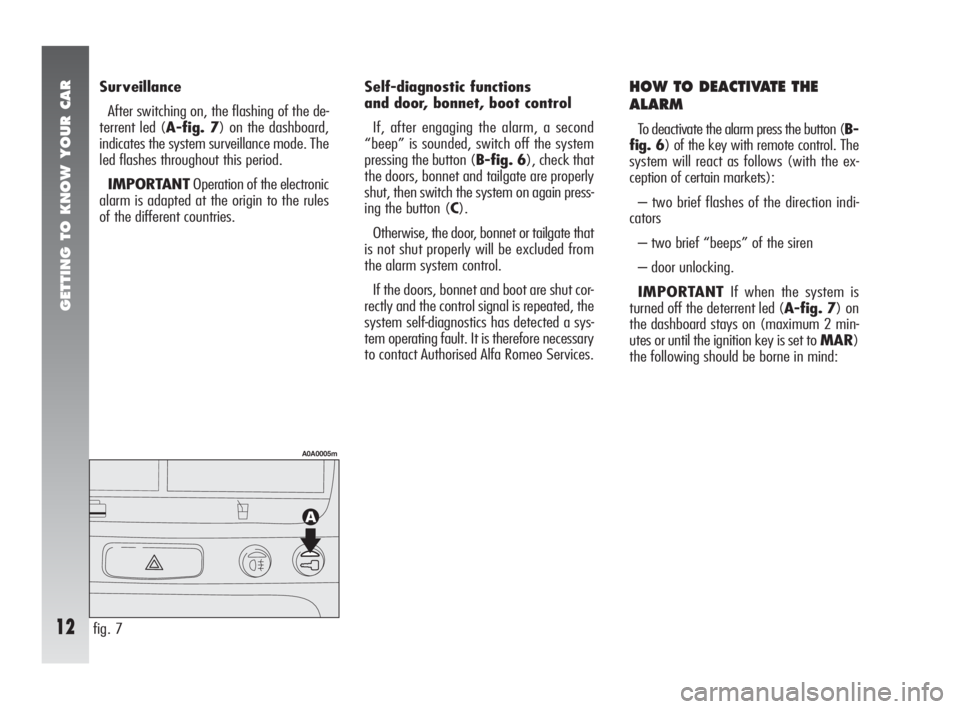
GETTING TO KNOW YOUR CAR
12
Surveillance
After switching on, the flashing of the de-
terrent led (A-fig. 7) on the dashboard,
indicates the system surveillance mode. The
led flashes throughout this period.
IMPORTANTOperation of the electronic
alarm is adapted at the origin to the rules
of the different countries.Self-diagnostic functions
and door, bonnet, boot control
If, after engaging the alarm, a second
“beep” is sounded, switch off the system
pressing the button (B-fig. 6), check that
the doors, bonnet and tailgate are properly
shut, then switch the system on again press-
ing the button (C).
Otherwise, the door, bonnet or tailgate that
is not shut properly will be excluded from
the alarm system control.
If the doors, bonnet and boot are shut cor-
rectly and the control signal is repeated, the
system self-diagnostics has detected a sys-
tem operating fault. It is therefore necessary
to contact Authorised Alfa Romeo Services.HOW TO DEACTIVATE THE
ALARM
To deactivate the alarm press the button (B-
fig. 6) of the key with remote control. The
system will react as follows (with the ex-
ception of certain markets):
– two brief flashes of the direction indi-
cators
– two brief “beeps” of the siren
– door unlocking.
IMPORTANTIf when the system is
turned off the deterrent led (A-fig. 7) on
the dashboard stays on (maximum 2 min-
utes or until the ignition key is set to MAR)
the following should be borne in mind:
fig. 7
A0A0005m
Page 45 of 291

GETTING TO KNOW YOUR CAR
43
Flashing(fig. 56)
The headlights are flashed pulling the lever
towards the steering wheel (instable posi-
tion) regardless of the position of the
knurled ring. The
1warning light on the
cluster will come on at the same time.
IMPORTANTOnly the main-beam lights
are flashed. To avoid penalties follow local
regulations.
Direction indicators (fig. 57)
Regardless of the position of the knurled
ring, moving the lever to the stable position
will:
up, position (1) - engage the right-hand
direction indicators;
down, position (2) - engage the left-hand
direction indicators.One of the warning lights (
RorE) will
come on on the instrument cluster at the
same time.
The lever is returned to its home position
automatically and the indicators are
switched off when the steering wheel is
straightened.
IMPORTANTIf you wish to signal a
rapid change of direction involving only a
minimal movement of the steering wheel,
the lever can be moved up or down without
it clicking (unstable position). When re-
leased, the lever will return to its home po-
sition. When low beams and fog lights turned
on, the external light control unit (integral
into the Body Computer) can behave ac-
cording to one of the following logic:
– as the high beams are turned on, the
low beams turn off, in the meanwhile the
fog lights remain on, and the starting con-
ditions are restored, as soon as the low
beams are turned on again;
– otherwise, when the high beams are
turned on, the fog lights are turned off, and
they will automatically be turned on again
when the high beams are turned off.
Hence, should the Body Computer be re-
placed, the lights management logic could
differ from the previous one.
fig. 56
A0A0067m
fig. 58
A0A0067m
fig. 57
A0A0068m
Page 71 of 291
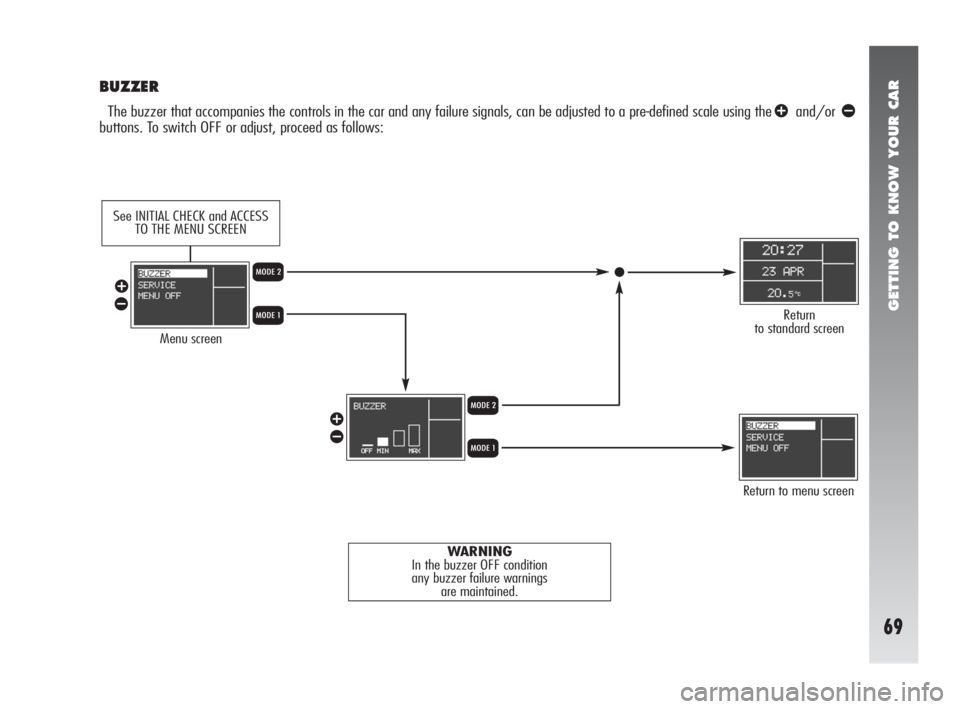
GETTING TO KNOW YOUR CAR
69
BUZZER
The buzzer that accompanies the controls in the car and any failure signals, can be adjusted to a pre-defined scale using theâand/orãbuttons. To switch OFF or adjust, proceed as follows:
Menu screen
Return to menu screen
Return
to standard screenQ
Q R
R
â
ã
â
ã
WARNING
In the buzzer OFF condition
any buzzer failure warnings
are maintained.
See INITIAL CHECK and ACCESS
TO THE MENU SCREEN
Page 94 of 291
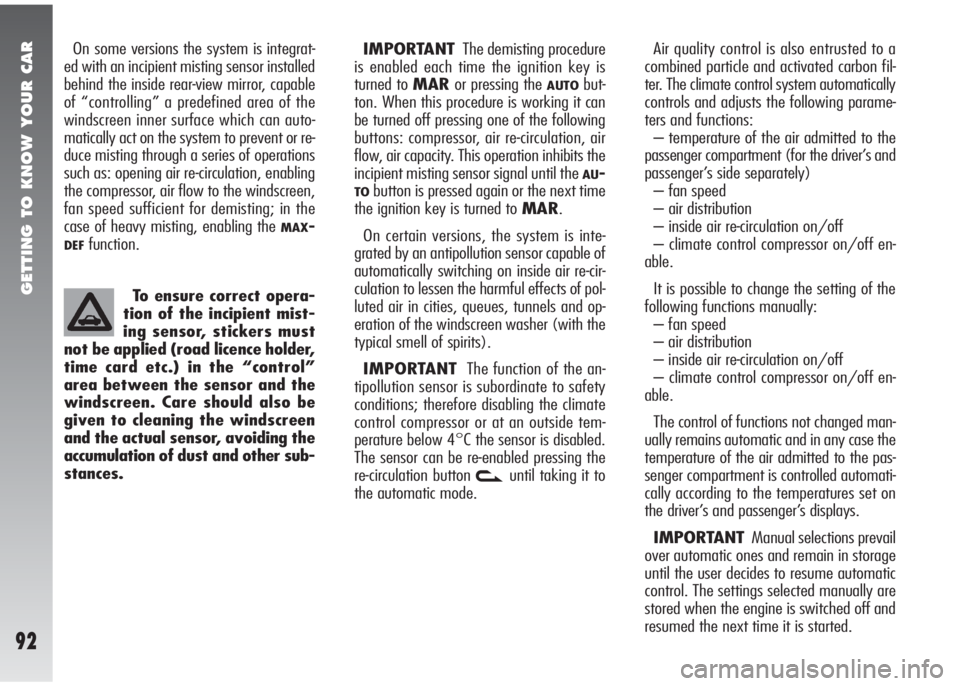
GETTING TO KNOW YOUR CAR
92
Air quality control is also entrusted to a
combined particle and activated carbon fil-
ter. The climate control system automatically
controls and adjusts the following parame-
ters and functions:
– temperature of the air admitted to the
passenger compartment (for the driver’s and
passenger’s side separately)
– fan speed
– air distribution
– inside air re-circulation on/off
– climate control compressor on/off en-
able.
It is possible to change the setting of the
following functions manually:
– fan speed
– air distribution
– inside air re-circulation on/off
– climate control compressor on/off en-
able.
The control of functions not changed man-
ually remains automatic and in any case the
temperature of the air admitted to the pas-
senger compartment is controlled automati-
cally according to the temperatures set on
the driver’s and passenger’s displays.
IMPORTANTManual selections prevail
over automatic ones and remain in storage
until the user decides to resume automatic
control. The settings selected manually are
stored when the engine is switched off and
resumed the next time it is started. To ensure correct opera-
tion of the incipient mist-
ing sensor, stickers must
not be applied (road licence holder,
time card etc.) in the “control”
area between the sensor and the
windscreen. Care should also be
given to cleaning the windscreen
and the actual sensor, avoiding the
accumulation of dust and other sub-
stances.IMPORTANTThe demisting procedure
is enabled each time the ignition key is
turned to MARor pressing the
AUTObut-
ton. When this procedure is working it can
be turned off pressing one of the following
buttons: compressor, air re-circulation, air
flow, air capacity. This operation inhibits the
incipient misting sensor signal until the
AU-
TObutton is pressed again or the next time
the ignition key is turned to MAR.
On certain versions, the system is inte-
grated by an antipollution sensor capable of
automatically switching on inside air re-cir-
culation to lessen the harmful effects of pol-
luted air in cities, queues, tunnels and op-
eration of the windscreen washer (with the
typical smell of spirits).
IMPORTANTThe function of the an-
tipollution sensor is subordinate to safety
conditions; therefore disabling the climate
control compressor or at an outside tem-
perature below 4°C the sensor is disabled.
The sensor can be re-enabled pressing the
re-circulation button
vuntil taking it to
the automatic mode. On some versions the system is integrat-
ed with an incipient misting sensor installed
behind the inside rear-view mirror, capable
of “controlling” a predefined area of the
windscreen inner surface which can auto-
matically act on the system to prevent or re-
duce misting through a series of operations
such as: opening air re-circulation, enabling
the compressor, air flow to the windscreen,
fan speed sufficient for demisting; in the
case of heavy misting, enabling the
MAX-
DEFfunction.
Page 113 of 291
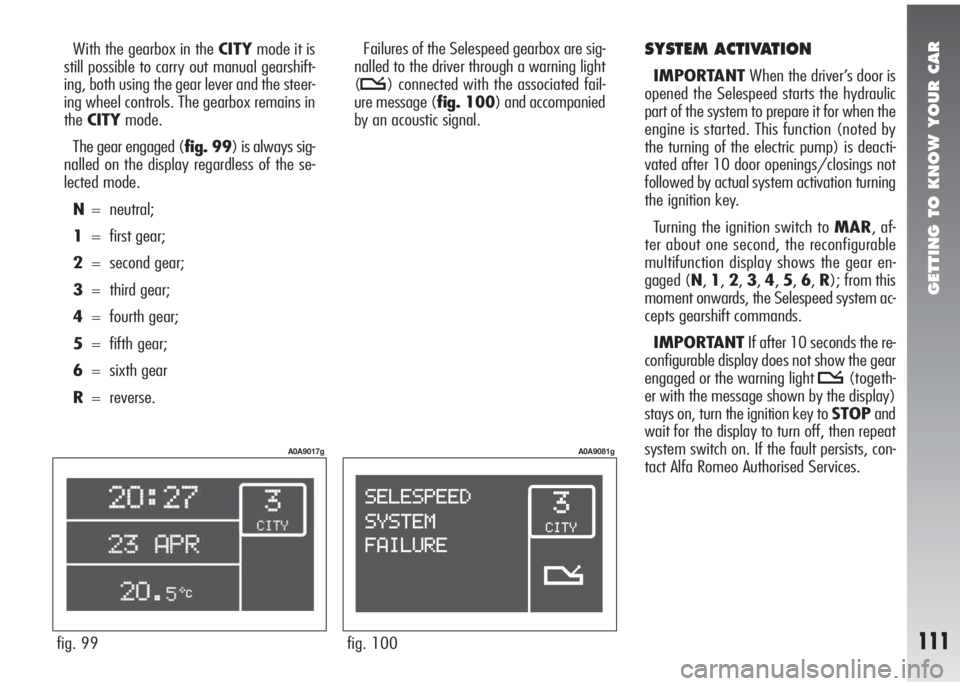
GETTING TO KNOW YOUR CAR
111fig. 99
A0A9017g
fig. 100
A0A9081g
With the gearbox in the CITYmode it is
still possible to carry out manual gearshift-
ing, both using the gear lever and the steer-
ing wheel controls. The gearbox remains in
theCITYmode.
The gear engaged (fig. 99) is always sig-
nalled on the display regardless of the se-
lected mode.
N= neutral;
1= first gear;
2= second gear;
3= third gear;
4= fourth gear;
5= fifth gear;
6= sixth gear
R= reverse.Failures of the Selespeed gearbox are sig-
nalled to the driver through a warning light
(
t) connected with the associated fail-
ure message (fig. 100) and accompanied
by an acoustic signal.
SYSTEM ACTIVATION
IMPORTANTWhen the driver’s door is
opened the Selespeed starts the hydraulic
part of the system to prepare it for when the
engine is started. This function (noted by
the turning of the electric pump) is deacti-
vated after 10 door openings/closings not
followed by actual system activation turning
the ignition key.
Turning the ignition switch to MAR, af-
ter about one second, the reconfigurable
multifunction display shows the gear en-
gaged (N,1,2,3,4,5,6,R); from this
moment onwards, the Selespeed system ac-
cepts gearshift commands.
IMPORTANTIf after 10 seconds the re-
configurable display does not show the gear
engaged or the warning light
t(togeth-
er with the message shown by the display)
stays on, turn the ignition key to STOPand
wait for the display to turn off, then repeat
system switch on. If the fault persists, con-
tact Alfa Romeo Authorised Services.
Page 120 of 291
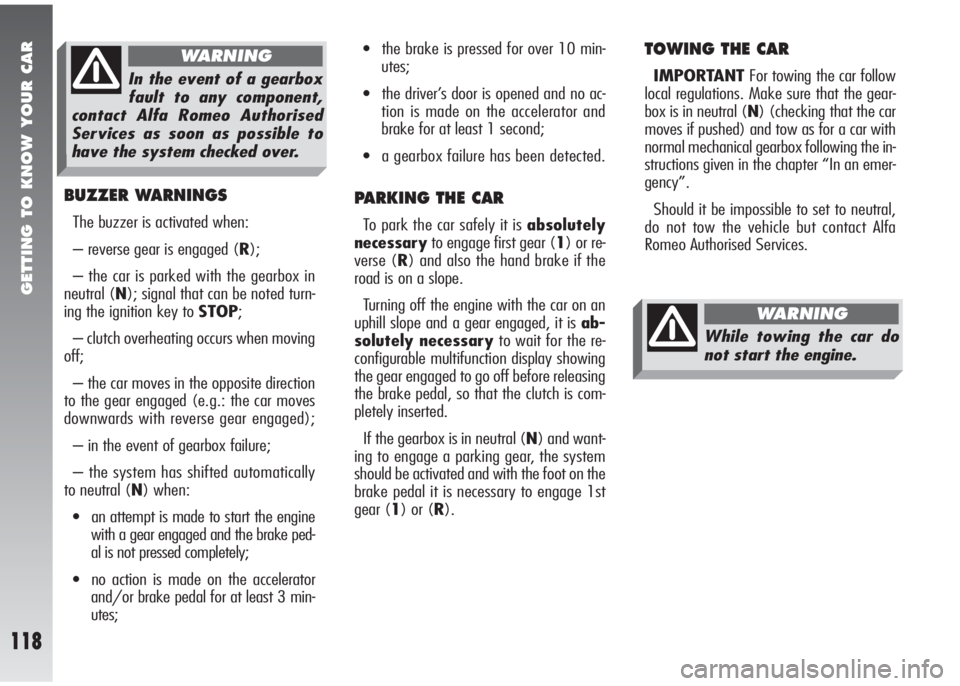
GETTING TO KNOW YOUR CAR
118
BUZZER WARNINGS
The buzzer is activated when:
– reverse gear is engaged (R);
– the car is parked with the gearbox in
neutral (N); signal that can be noted turn-
ing the ignition key to STOP;
– clutch overheating occurs when moving
off;
– the car moves in the opposite direction
to the gear engaged (e.g.: the car moves
downwards with reverse gear engaged);
– in the event of gearbox failure;
– the system has shifted automatically
to neutral (N) when:
•an attempt is made to start the engine
with a gear engaged and the brake ped-
al is not pressed completely;
•no action is made on the accelerator
and/or brake pedal for at least 3 min-
utes;
•the brake is pressed for over 10 min-
utes;
•the driver’s door is opened and no ac-
tion is made on the accelerator and
brake for at least 1 second;
•a gearbox failure has been detected.
PARKING THE CAR
To park the car safely it is absolutely
necessaryto engage first gear (1) or re-
verse (R) and also the hand brake if the
road is on a slope.
Turning off the engine with the car on an
uphill slope and a gear engaged, it is ab-
solutely necessaryto wait for the re-
configurable multifunction display showing
the gear engaged to go off before releasing
the brake pedal, so that the clutch is com-
pletely inserted.
If the gearbox is in neutral (N) and want-
ing to engage a parking gear, the system
should be activated and with the foot on the
brake pedal it is necessary to engage 1st
gear (1) or (R).
TOWING THE CAR
IMPORTANTFor towing the car follow
local regulations. Make sure that the gear-
box is in neutral (N) (checking that the car
moves if pushed) and tow as for a car with
normal mechanical gearbox following the in-
structions given in the chapter “In an emer-
gency”.
Should it be impossible to set to neutral,
do not tow the vehicle but contact Alfa
Romeo Authorised Services.
While towing the car do
not start the engine.
WARNING
In the event of a gearbox
fault to any component,
contact Alfa Romeo Authorised
Services as soon as possible to
have the system checked over.
WARNING
Page 136 of 291
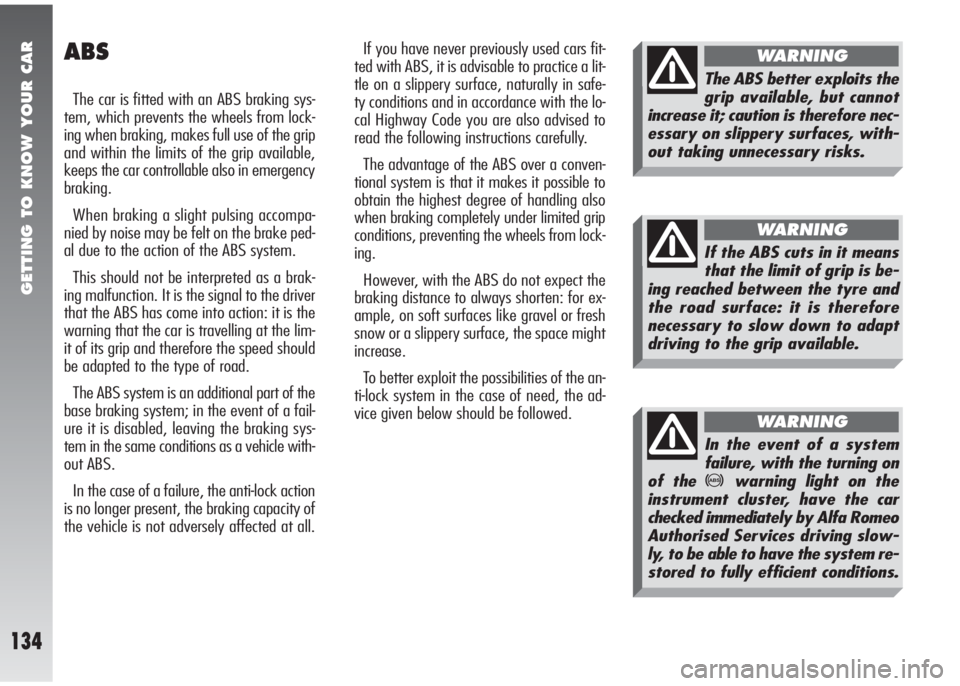
GETTING TO KNOW YOUR CAR
134
ABS
The car is fitted with an ABS braking sys-
tem, which prevents the wheels from lock-
ing when braking, makes full use of the grip
and within the limits of the grip available,
keeps the car controllable also in emergency
braking.
When braking a slight pulsing accompa-
nied by noise may be felt on the brake ped-
al due to the action of the ABS system.
This should not be interpreted as a brak-
ing malfunction. It is the signal to the driver
that the ABS has come into action: it is the
warning that the car is travelling at the lim-
it of its grip and therefore the speed should
be adapted to the type of road.
The ABS system is an additional part of the
base braking system; in the event of a fail-
ure it is disabled, leaving the braking sys-
tem in the same conditions as a vehicle with-
out ABS.
In the case of a failure, the anti-lock action
is no longer present, the braking capacity of
the vehicle is not adversely affected at all.If you have never previously used cars fit-
ted with ABS, it is advisable to practice a lit-
tle on a slippery surface, naturally in safe-
ty conditions and in accordance with the lo-
cal Highway Code you are also advised to
read the following instructions carefully.
The advantage of the ABS over a conven-
tional system is that it makes it possible to
obtain the highest degree of handling also
when braking completely under limited grip
conditions, preventing the wheels from lock-
ing.
However, with the ABS do not expect the
braking distance to always shorten: for ex-
ample, on soft surfaces like gravel or fresh
snow or a slippery surface, the space might
increase.
To better exploit the possibilities of the an-
ti-lock system in the case of need, the ad-
vice given below should be followed.
If the ABS cuts in it means
that the limit of grip is be-
ing reached between the tyre and
the road surface: it is therefore
necessary to slow down to adapt
driving to the grip available.
WARNING
The ABS better exploits the
grip available, but cannot
increase it; caution is therefore nec-
essary on slippery surfaces, with-
out taking unnecessary risks.
WARNING
In the event of a system
failure, with the turning on
of the
>warning light on the
instrument cluster, have the car
checked immediately by Alfa Romeo
Authorised Services driving slow-
ly, to be able to have the system re-
stored to fully efficient conditions.
WARNING
Page 138 of 291
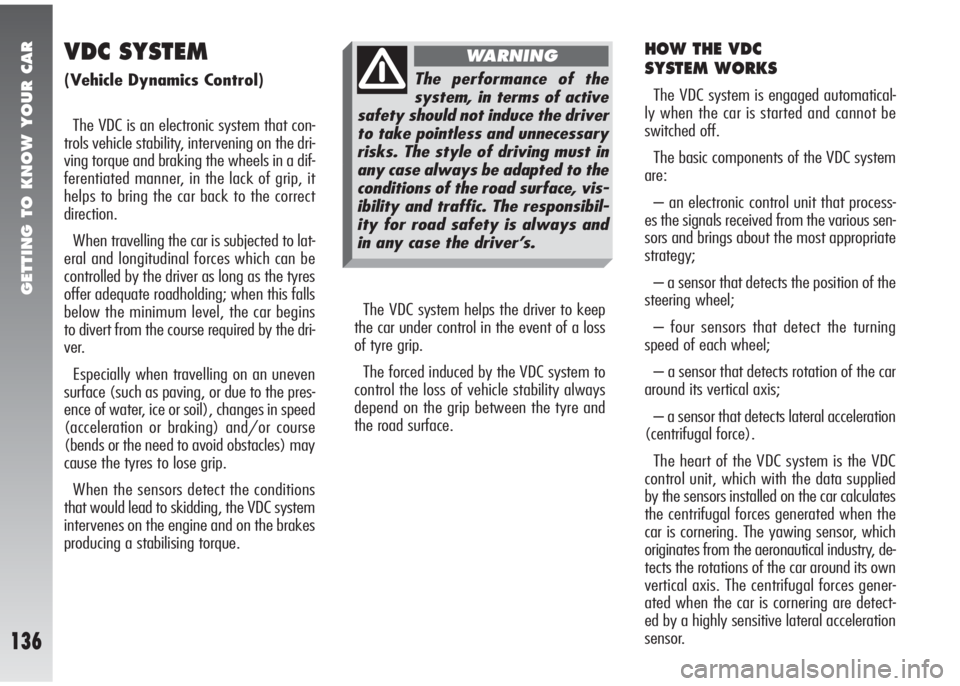
GETTING TO KNOW YOUR CAR
136
VDC SYSTEM
(Vehicle Dynamics Control)
The VDC is an electronic system that con-
trols vehicle stability, intervening on the dri-
ving torque and braking the wheels in a dif-
ferentiated manner, in the lack of grip, it
helps to bring the car back to the correct
direction.
When travelling the car is subjected to lat-
eral and longitudinal forces which can be
controlled by the driver as long as the tyres
offer adequate roadholding; when this falls
below the minimum level, the car begins
to divert from the course required by the dri-
ver.
Especially when travelling on an uneven
surface (such as paving, or due to the pres-
ence of water, ice or soil), changes in speed
(acceleration or braking) and/or course
(bends or the need to avoid obstacles) may
cause the tyres to lose grip.
When the sensors detect the conditions
that would lead to skidding, the VDC system
intervenes on the engine and on the brakes
producing a stabilising torque.
HOW THE VDC
SYSTEM WORKS
The VDC system is engaged automatical-
ly when the car is started and cannot be
switched off.
The basic components of the VDC system
are:
– an electronic control unit that process-
es the signals received from the various sen-
sors and brings about the most appropriate
strategy;
– a sensor that detects the position of the
steering wheel;
– four sensors that detect the turning
speed of each wheel;
– a sensor that detects rotation of the car
around its vertical axis;
– a sensor that detects lateral acceleration
(centrifugal force).
The heart of the VDC system is the VDC
control unit, which with the data supplied
by the sensors installed on the car calculates
the centrifugal forces generated when the
car is cornering. The yawing sensor, which
originates from the aeronautical industry, de-
tects the rotations of the car around its own
vertical axis. The centrifugal forces gener-
ated when the car is cornering are detect-
ed by a highly sensitive lateral acceleration
sensor. The VDC system helps the driver to keep
the car under control in the event of a loss
of tyre grip.
The forced induced by the VDC system to
control the loss of vehicle stability always
depend on the grip between the tyre and
the road surface.
The performance of the
system, in terms of active
safety should not induce the driver
to take pointless and unnecessary
risks. The style of driving must in
any case always be adapted to the
conditions of the road surface, vis-
ibility and traffic. The responsibil-
ity for road safety is always and
in any case the driver’s.
WARNING
Page 139 of 291
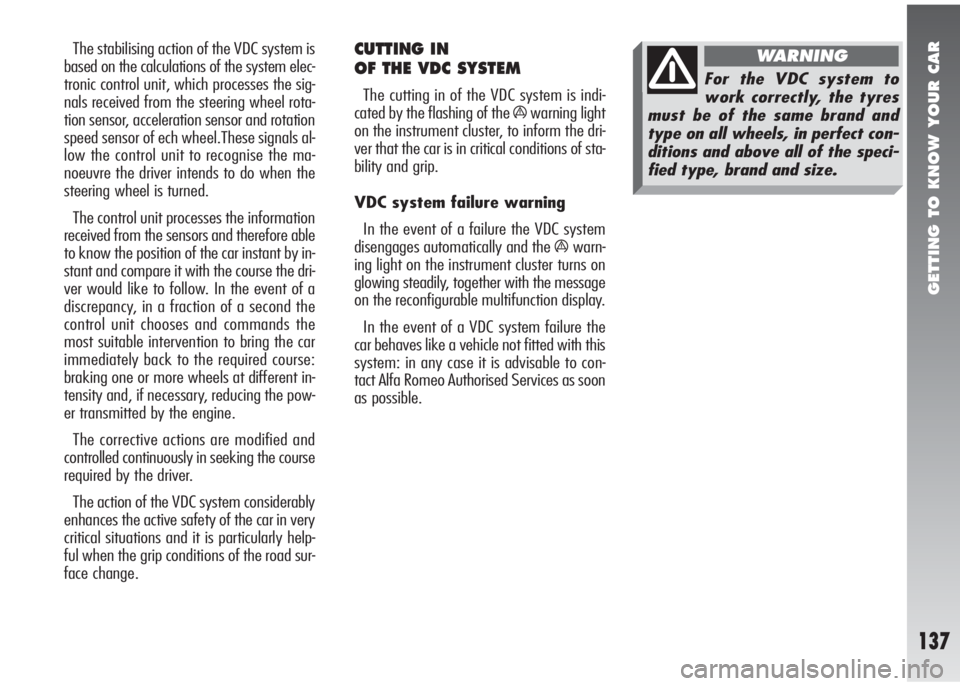
GETTING TO KNOW YOUR CAR
137
The stabilising action of the VDC system is
based on the calculations of the system elec-
tronic control unit, which processes the sig-
nals received from the steering wheel rota-
tion sensor, acceleration sensor and rotation
speed sensor of ech wheel.These signals al-
low the control unit to recognise the ma-
noeuvre the driver intends to do when the
steering wheel is turned.
The control unit processes the information
received from the sensors and therefore able
to know the position of the car instant by in-
stant and compare it with the course the dri-
ver would like to follow. In the event of a
discrepancy, in a fraction of a second the
control unit chooses and commands the
most suitable intervention to bring the car
immediately back to the required course:
braking one or more wheels at different in-
tensity and, if necessary, reducing the pow-
er transmitted by the engine.
The corrective actions are modified and
controlled continuously in seeking the course
required by the driver.
The action of the VDC system considerably
enhances the active safety of the car in very
critical situations and it is particularly help-
ful when the grip conditions of the road sur-
face change.CUTTING IN
OF THE VDC SYSTEM
The cutting in of the VDC system is indi-
cated by the flashing of the
áwarning light
on the instrument cluster, to inform the dri-
ver that the car is in critical conditions of sta-
bility and grip.
VDC system failure warning
In the event of a failure the VDC system
disengages automatically and the
áwarn-
ing light on the instrument cluster turns on
glowing steadily, together with the message
on the reconfigurable multifunction display.
In the event of a VDC system failure the
car behaves like a vehicle not fitted with this
system: in any case it is advisable to con-
tact Alfa Romeo Authorised Services as soon
as possible.
For the VDC system to
work correctly, the tyres
must be of the same brand and
type on all wheels, in perfect con-
ditions and above all of the speci-
fied type, brand and size.
WARNING
Page 149 of 291

GETTING TO KNOW YOUR CAR
147
RDS (Radio Data System)
This is a radiophonic information system
which uses the 57 kHz subcarrier of normal
FM broadcasts.
With this function it is possible to receive
different types of information such as traf-
fic bulletins and station names and to au-
tomatically tune to a station with the
strongest signal that is broadcasting the
same programme.
REG (Regional transmission
reception function)
Function with which it is possible to tune
only to local (regional) stations.
Repeat
Function with which it is possible to con-
tinuously listen to the last track played on
the Compact Disc.
Scan
Function with which it is possible to listen
for a few seconds to all the radio stations
stored, or the beginning of all the tracks con-
tained on the Compact Disc.Scrolling
Function with which it is possible to receive
different programmes in the same network
(in the FM band only).
PLL Tuning
Digital tuning with Phase Lock Loop circuit
to obtain the best radio channel tuning.
Soft Mute
Function that gradually highers and low-
ers the volume when Mute is turned on or
off.
Sound Flavour
A function that sets the best equalizing pos-
sible depending on the type of music se-
lected (Classic, Jazz, Rock, etc).
SVC
Function that automatically adjusts the lev-
el of the volume to the speed of the car to
maintain the ratio with the noise level in the
passenger compartment.TA (Traffic information)
Function with which it is possible to receive
the traffic information broadcast by the sta-
tions enabled, also when tuned to another
station or listening to a cassette, CD, or dur-
ing a phone call.
TPM (Track Program Memory)
Function with which it is possible to store
the sequence for playing the tracks of a CD,
to be able to play them later in the sequence
set.
Treble
This adjusts the treble tones.